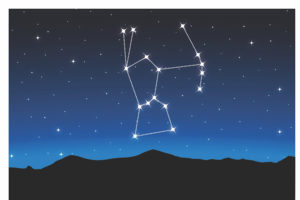With the end of daylight savings time, it’s suddenly darker much earlier in the evening. You may notice that the night sky has changed since those beach bonfires back in August. Look east around 9 p.m., and you’ll see Orion the Hunter rising, which you probably haven’t seen since last winter. Why is that? What causes the progression of constellations over the course of the year?

I’ve found that a demonstration using concrete visualization works best to answer that question. The demo requires a little preparation and could be a fun activity for a rainy November afternoon when the internet goes out and you can’t watch Netflix.
You’ll need a candle, a mug with handle, a table, and, in addition to yourself, four brave volunteers. You’ll also need to make four small signs (regular printer paper will do). Label the signs Orion (Winter), Leo (Spring), Cygnus (Summer), and Pegasus (Fall). (Each is a prominent constellation for that season.) Make sure the writing is big enough to be seen from several feet away.
The demo works even better if you look up those constellations online and sketch them on the signs. Are your volunteers five years old, in numerical or spiritual age? Have them dress up as the constellations. Orion needs a (toy) club and stuffed animal to hold up. How about lion claws for Leo? Cygnus is a swan, so wings would do nicely, and the same for Pegasus.
To set up the demo: light the candle and place it in the center of your table. Place the mug on the table at least 12 inches from the candle, or more if possible. Then evenly distribute your four volunteers in a circle around the table, standing a few feet back. Give each of them a sign, in the correct order of the seasons. Turn the lights off.
Now the candle is the Sun, the mug is the Earth, and your volunteers are the constellations, positioned (very roughly) as they are in the sky. Remember how I specified a mug with a handle? The handle represents you, wherever you happen to be on the planet — let’s say Outer Cape Cod. Twist the mug until the handle points at the candle — high noon on the Outer Cape. Now twist the mug 90 degrees, so that one side of the handle faces the Sun, and the other faces the room — sunset. Twist another 90 degrees, so the handle points away from the candle into the room — midnight.
Now move the mug in a wide circle on the table around the candle. Once you’re back where you started, you’ve completed one orbit — which we also call one year. Move the mug again through an orbit, watching the weeks and months fly by, and stop whenever you’re in line with one of your constellation-volunteers. Twist the mug so the handle points at him or her. That’s the constellation visible at night at that time of year. (Of course, there are many more constellations, but we only have so many friends to work with.)
Keep the mug where it is and twist it so the handle faces the candle — now it’s daytime. Can you see how the candle — the Sun — prevents you from seeing the constellation you’re now facing? Twist it 90 degrees one way or the other. Can you see how the constellations that are just “out of season” — that is, a little ahead or behind as we orbit — are visible for a short time after sunset or before sunrise?
Now continue moving the mug. Can you see how as the Earth orbits the Sun — as the seasons progress — one constellation moves out of view, and another moves into view? That’s why our night sky changes throughout the year. But everything is in motion, even the stars — they just move very slowly from our point of view, because they are so far away. Our night sky will be very different 100,000 years from now — if we’re still around to look up.
Clear skies!



